The Complete Guide to Power Paddleboarding Adventures
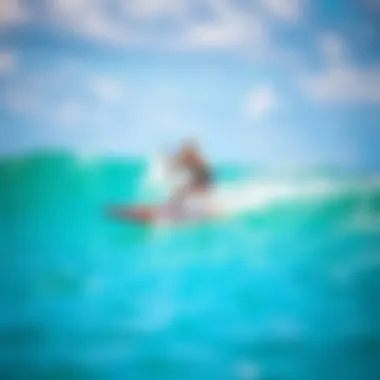
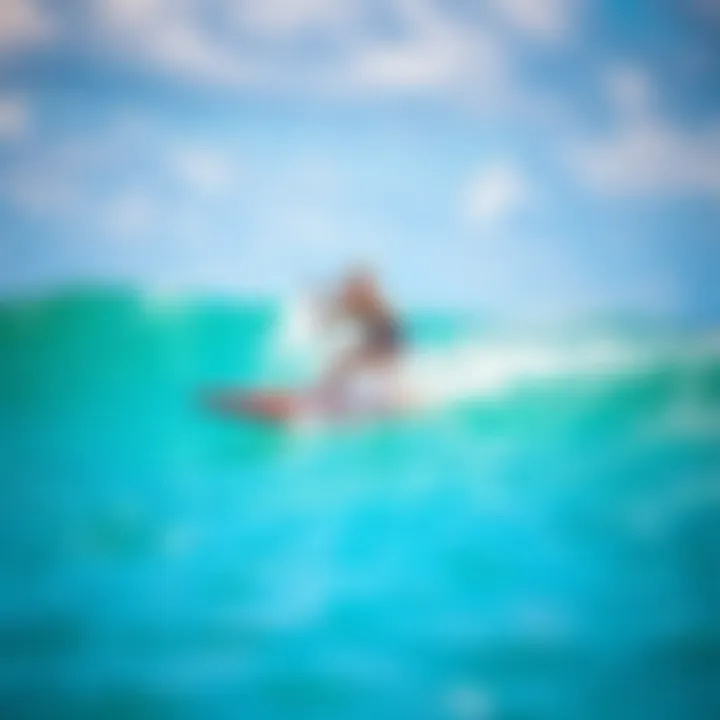
Intro
Power paddleboarding has become a thrilling combination of speed and stability on the water. This exciting sport, marrying elements of traditional paddleboarding with advanced motorized technology, is gaining traction among both casual beachgoers and avid outdoor enthusiasts. To really understand what makes power paddleboarding so engaging, one must delve into its gear, skills, and the lifestyle surrounding it.
Gone are the days when paddleboards were purely propelled by human strength. Today, innovations in design and technology have crafted boards that can glide effortlessly while a user sits or stands comfortably. No matter your skill level, whether you're a newbie looking to explore the waters or a seasoned veteran aiming to perfect advanced techniques, this guide walks you through everything you need to know.
Gear and Equipment
The advent of power paddleboarding has introduced new gear that not only enhances performance but also ensures safety and comfort on the water. Understanding these vital components is essential for anyone looking to invest in the sport.
Latest Surfboard Technologies
Modern power paddleboards come equipped with features that make a noticeable difference in how they perform:
- Electric Engines: Most paddleboards now utilize lightweight, efficient electric engines, providing a reliable speed boost. This is a game changer, especially for longer distances or against currents.
- Advanced Materials: Boards made with carbon fiber or high-density polyethylene not only enhance rigidity but also reduce weight, allowing for better maneuverability.
- Hydrofoil Additions: Hydrofoils lift the board above the water, creating a smooth and fast ride that feels almost like flying. This technology is gaining popularity for both recreational and competitive power paddleboarding.
"Power paddleboarding combines adventure with innovation, elevating the experience to new heights."
Essential Accessories for Every Surfer
Aside from the board itself, there are several accessories crucial to improve your power paddleboarding escapades:
- Life Jackets: Always prioritize safety with a good quality, comfortable life vest. Even for experienced paddlers, this is a must.
- Paddle Leash: Keeping your paddle close is vital, preventing it from floating away while you navigate tougher waters.
- Waterproof Bags: For those trips that extend into the day, having a waterproof bag for your electronics and snacks can be invaluable.
By understanding the essential gear and equipment for power paddleboarding, one can truly maximize their time on the water.
Surf Techniques and Skills
Navigating the waters while on a power paddleboard can require a different set of techniques compared to traditional paddleboarding. Here’s a look at some skills that might be beneficial:
Beginner Surfing Techniques
For newcomers, mastering the basics is necessary to instill confidence:
- Mounting the Board: Practice getting on and off the board in calm waters.
- Balancing: Focus on spreading your feet shoulder-width apart and keeping your knees slightly bent for stability.
- Basic Steering: Use your paddle effectively to steer, dipping it into the water on the side you wish to turn toward.
Advanced Maneuvers for Experienced Surfers
Once comfortable, paddleboarders can explore advanced skills that take the experience further:
- Slicing Through Choppy Waters: Learning how to tilt the board and use the paddle to create momentum helps in rough conditions.
- Riding Swells: Understanding how to position oneself to catch waves can enhance the thrill factor exponentially.
- Precision Stopping: Master your stopping techniques to perform sharp turns or halt quickly when needed.
As with any activity on the water, practice is key. The more time spent mastering these skills, the more enjoyable one’s outings will be.
For more tips and guidance on power paddleboarding techniques and gear, visit Wikipedia and check out dedicated forums on Reddit to connect with fellow enthusiasts.
Preface to Power Paddleboarding
Power paddleboarding has gained traction over the last few years, drawing in a diverse crowd from experienced surfers to newcomers eager to embrace life on the water. This section serves as a foundation for understanding the multifaceted nature of power paddleboarding, highlighting its importance in contemporary water sports.
One of the most significant elements of this sport lies in its unique blend of exhilaration and accessibility. With power paddleboards, participants can traverse larger areas of water without the fatigue that often accompanies traditional paddling. This characteristic opens up possibilities for longer excursions and greater exploration of scenic coastlines and tranquil lakes. As interest in eco-friendly recreation grows, power paddleboarding emerges as a sustainable choice, allowing intimate interactions with nature while minimizing impact on the environment.
Understanding Power Paddleboarding
At its core, power paddleboarding combines the thrill of surfing with the efficiency of powered propulsion. Unlike standard paddleboards, these vessels utilize an integrated power source, which can be electric or manual, providing speed and convenience. This dual approach caters to a broad range of experience levels, making it suitable for everyone, from seasoned athletes to those new to water sports.
Whether cruising through calm waters or navigating choppy surf, learners can quickly develop their skills without the intimidating aspects of traditional paddleboarding. Not merely a method of transport, power paddleboarding encourages a sense of independence and adventure, essentially transforming how individuals experience aquatic settings. The sport encourages a community spirit, as enthusiasts often gather at local spots, sharing tips, stories, and the beauty of their surroundings.
Historical Background of Paddleboarding
To appreciate power paddleboarding, one can look back to the roots of traditional paddleboarding. While its exact origin is debated, many scholars trace the practice back to ancient Polynesian cultures. Originally, the Polynesians used large boards to navigate their waters, a necessity for fishing and transportation.
Over time, it became a popular pastime in the Hawaiian Islands, growing in popularity during the 20th century, especially following the rise of surf culture. The modern paddleboard has evolved significantly since its early days, being constructed from materials like foam and fiberglass, which are both lightweight and durable. With advancements in technology, power paddleboarding came into play, introducing electric thrusters and battery systems, changing the game completely. Today, the sport is a fusion of history and innovation, making waves not just in the ocean but in lakes and rivers around the world.
Power paddleboarding thus embodies both tradition and modernity, bridging the gap between past practices and future possibilities.
"Power Paddleboarding signifies more than just a sport; it represents a lifestyle choice committed to exploration, freedom, and sustainability." - Paddleboarding Enthusiast
For those eager to learn more about the historical aspects of paddleboarding, reliable references can be found on Wikipedia and Britannica. The community thrives on platforms like Reddit, where users share experiences and advice on power paddleboarding.
Technology Behind Power Paddleboards
Power paddleboarding is not just about riding the waves or gliding across the lake; it’s fundamentally fueled by cutting-edge technology. Understanding the technology behind power paddleboards amplifies the experience, making it enjoyable and feasible for both amateurs and veterans. This section highlights the different power systems, the pivotal features that come into play, and how they enhance the sport while keeping safety in mind.
Electric vs. Manual Power Sources
When it comes to power sources, paddleboards generally come in two flavors: electric and manual.
Electric Power Sources
Electric paddleboards have surged in popularity thanks to their ability to deliver smooth, consistent propulsion without the physical effort. These boards are equipped with electric motors powered by batteries. Unlike traditional manual boards, which require paddling, electric boards allow users to conserve energy for longer outings. This can be particularly helpful for those looking to explore vast water expanses or for beginners who may find paddling labor-intensive. However, the downside includes the necessity to regularly charge batteries and increased weight due to the added components.
Manual Power Sources
On the other hand, manual paddleboards rely entirely on the paddler's effort. While they might not offer the same ease of cruising, they require minimal equipment, making them more accessible in terms of maintenance and preparation. A robust workout can be achieved through manual paddling, fostering physical resilience and strength. There is also an option for hybrid boards, combining both methods which can be appealing to a broader audience.
Key Features of Modern Power Paddleboards
Understanding the nuanced components of power paddleboards can significantly elevate the paddling experience. Several key features stand out as particularly relevant, each contributing to overall efficiency, usability, and enjoyment.
Propulsion Systems
The main event when discussing any power paddleboard is its propulsion system. These systems can be thoroughly categorized into jet propulsion and traditional propellers. Jet propulsion uses water intake and expulsion to generate thrust, offering a lower risk of damage to marine life and surroundings. Propeller systems, on the other hand, are more prevalent and deliver a thrilling speed, which some paddlers seek. However, one must be cautious of the noise and potential hazards that may arise from exposed propellers.
Battery Life and Efficiency
Battery life can break or make paddleboarding trips. An efficient battery ensures that paddlers don’t get stranded in the middle of the ocean or a secluded lake. Modern designs often boast long-lasting lithium-ion batteries, which come with substantial power density and enhanced lifespan. The essential characteristic to look out for is not just capacity in amp-hours but also the charging time. A prolonged charging duration could lead to downtime that dampens the excitement.

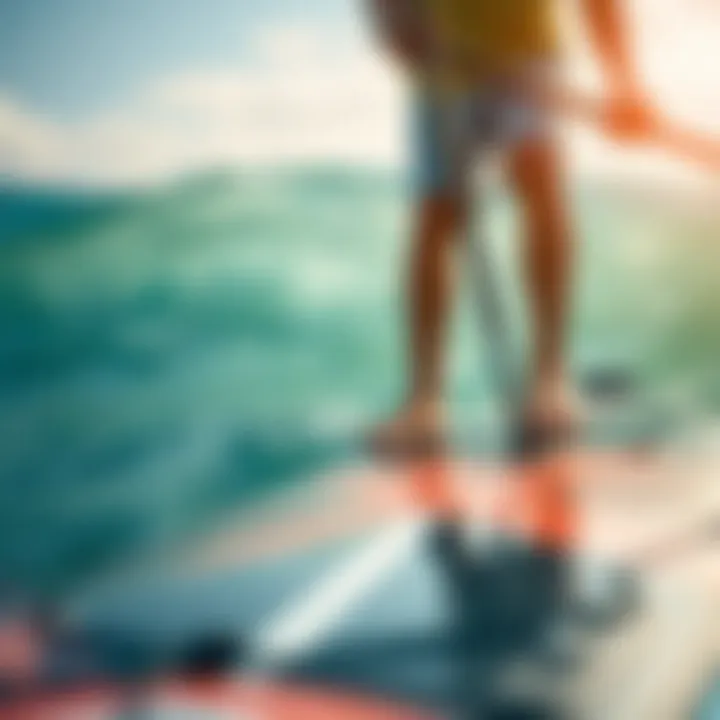
Control Mechanisms
Control over the paddleboard makes all the difference—this can range from simple manual levers to advanced wireless remotes. A notable trend in contemporary paddleboards is the move towards intuitive control systems that couple with app-based settings. This level of granularity allows enthusiasts to customize their speed and responsiveness with ease. The downside is that more control features can mean a steeper learning curve for newcomers, so striking a balance is crucial.
As technology advances, the experience of paddleboarding becomes not just about riding – it’s about an immersive journey with the elements.
Power paddleboarding is constantly evolving—technology plays a crucial role in delivering enjoyable experiences while making the activity more accessible to a diverse audience. Considering the differences between electric and manual sources, alongside the varied features of modern boards, any paddler can find their ideal match for adventure on the water.
Benefits of Power Paddleboarding
Power paddleboarding stands out not just as a thrilling water sport but also as an experience that merges the great outdoors with technology, creating unique advantages for participants. Embracing this activity offers a host of benefits that appeal to a wide audience, from adrenaline junkies to those seeking a leisurely day on the water. Understanding these benefits provides insight into why power paddleboarding has garnered such attention in recent years.
Enhanced Speed and Mobility
One of the primary draws of power paddleboarding is the increased speed it provides compared to traditional paddleboarding. Imagine gliding across the water, propelled by an electric motor, allowing you to cover greater distances in a shorter time. This is not just about speed; with this ability, enthusiasts can explore areas that may have once been hard to reach, making it possible to discover hidden coves or secluded beaches with ease.
- Faster Excursion: Power paddleboards allow for quick trips to distant locations, such as scenic views and fishing spots that might take hours to paddle to, all within a fraction of the time.
- Ease of Use: For those who find paddling physically demanding, power paddleboarding eliminates the exhaustion that typically comes after a long session on the water. You can enjoy longer outings, taking in the surroundings without the strain of continuous paddling.
Moreover, the mobility provided is unmatched. The adaptability of power paddleboards caters well to varied water conditions. Whether facing strong currents or winds, these boards often maintain stability and navigation ease, allowing users to cut through waves effectively and change directions smoothly.
Accessibility for All Skill Levels
Power paddleboarding opens up a world of possibilities, inviting individuals from myriad backgrounds to partake in water sports, regardless of their skill levels. This accessibility is vital in fostering a community around paddleboarding and expanding its appeal.
- Beginner-Friendly: Newcomers might feel daunted at the thought of paddleboarding, but with power assistance, they experience less stress. The extra propulsion allows novices to focus on balance and technique rather than sheer endurance.
- Inclusivity: Those with physical limitations who may have struggled with traditional paddling can find joy and independence in power paddleboarding. The boards generally have features tailored to accommodate various users, making it an inclusive sport.
"The beauty of power paddleboarding lies in its capacity to draw everyone into the exhilarating realm of water sports, fostering connection and enjoyment."
Experience matters less than enthusiasm. Families, friends, and beginners will all share the same exhilarating rides on the same boards, which builds stronger bonds.
Environmental Benefits
While many might think of power paddleboarding solely as a recreational pursuit, there are profound positive impacts on the environment associated with this sport. The eco-friendliness of power paddleboarding is evident in its thoughtful designs and use of technology.
- Low Emission: Most modern electric paddleboards use clean energy, often equipped with battery systems that minimize carbon footprints. These systems are designed to operate quietly, preserving the ambient sound of nature, encouraging a more serene experience.
- Less Disturbance: Unlike jet skis or motorboats that can be intrusive, power paddleboards glide with less water impact. This means that marine ecosystems are less disrupted, protecting delicate habitats.
Additionally, power paddleboarding can promote environmental stewardship among enthusiasts. Engaging in this sport often brings participants closer to nature, cultivating a personal connection that can motivate action toward protecting water bodies. More and more paddleboarders partake in activities like clean-up efforts, demonstrating the combined commitment to fun and environmental responsibility.
In sum, engaging in power paddleboarding is not just about enjoying the thrill of the ride but also recognizing the multifaceted benefits it offers. From its remarkable speed to its inclusive nature and eco-friendly attributes, it presents a compelling case to both seasoned water sport aficionados and newcomers alike.
Choosing the Right Power Paddleboard
Choosing the right power paddleboard is an essential step in ensuring not just a pleasurable experience on the water, but also safety and functionality tailored to your needs. With various models and specifications available, navigating through the options can feel like looking for a needle in a haystack. From beginners to seasoned pros, everyone can benefit from understanding the most pivotal factors involved in selecting the right paddleboard.
Key elements to consider include size, weight capacity, and material choice. These factors can make the difference between a smooth ride and a frustrating one. Each aspect intertwines closely with the intended use of the paddleboard, whether for leisurely paddling on calm waters or tackling more adventurous routes. The following subsections will highlight the specifications that one should evaluate closely while making a decision.
Evaluating Paddleboard Specifications
Size Considerations
Size matters when it comes to paddleboarding. A paddleboard that is too large can be cumbersome, whereas one that is too small may not provide the stability needed, especially for beginners. Generally, longer boards are beneficial for speed and tracking on water, while shorter boards offer better maneuverability.
For instance, typical sizes range from 10 to 14 feet. A board around 10’6” is often the sweet spot for versatility on lakes and rivers. However, a longer 12’6" or 14' board would serve better for open waters or longer-distance travel.
The unique feature of size is its direct impact on handling. A novice paddler might prefer a wider, more stable option, while experienced paddlers might lean towards something sleeker that can cut through the water with greater ease. The choice of size can significantly influence the enjoyment and effectiveness of your paddleboarding activities.
Weight Capacity
Understanding weight capacity is crucial, as it determines how much weight your paddleboard can safely carry. Each board has a maximum weight limit, often ranging from about 250 to 400 pounds. Knowing this figure helps you avoid the hassle of having to buy a new board when you're ready to invite a friend along or go out with gear.
The key characteristic here is clear: exceeding this limit can lead to compromised performance and even safety issues. For those who prefer to load up with coolers, camping gear, or even a friend, it's wise to consider a board that accommodates more than just your weight.
Additionally, the weight capacity explains how rigid and durable the board itself is. In essence, a board with a higher capacity may inherently have additional sturdiness built in, thus enhancing its durability in rough waters even while maintaining buoyancy.
Material Choices
Paddleboards are typically made from either inflatable or hard materials. Each material has its pros and cons, impacting everything from weight to maneuverability. For instance, inflatable boards are lighter and easier to transport, making them a good choice for those who roam around or have limited storage. They can be rolled up and stowed away, which could be handy if you live in an apartment or prefer travelling light.
On the other hand, hard boards, often made from fiberglass or epoxy, provide a solid feel and usually perform better in terms of speed and responsiveness. They can be a more reliable option in choppier waters, giving paddlers more confidence while navigating.
When considering material, think about your intended use. A solid board may be better suited for long-distance excursions, while an inflatable one caters to casual kayaking or paddleboarding with friends. Balancing these characteristics according to your lifestyle ultimately will shape your paddling journey.
Brand Comparisons
With numerous brands vying for your attention, selecting the right one can feel overwhelming. Popular brands, like BOTE, Red Paddle Co., and Isle Surf and SUP, offer different specializations and price points, catering to various segments of the paddleboarding community. Brand reputation often underscores durability, performance, and customer service, which can be critical factors in your long-term satisfaction with your board.
Researching reviews, testing boards in-store, and comparing warranty offers can significantly enhance your purchasing confidence and ensure that you’re spending money wisely on gear that meets your expectations.
Essential Gear for Power Paddleboarding
Engaging in power paddleboarding demands more than just enthusiasm for the water and wind. Having the right gear is crucial. Not only does proper equipment enhance safety, but it also elevates the overall experience on the water. Every piece of gear can play a role in ensuring fun and adventure without putting anyone at risk. Below, we'll explore essential gear selections that contribute greatly to the power paddleboarding experience.
Safety Equipment
Safety should always come first. Thoughtful selection of safety gear is essential, whether you're a novice or a seasoned paddler.
Life Jackets
Life jackets, or personal flotation devices (PFDs), are non-negotiable in power paddleboarding. They're designed to keep you afloat should you find yourself in an unexpected situation. Many paddleboarders prefer coastal models for their superior mobility and comfort. This type often features a slim profile, allowing for free arm movement while paddling. The unique aspect of life jackets lies in their buoyancy—designed to facilitate both safety and comfort.
Advantages include:
- Visibility: Many life jackets come in bright colors, enhancing your visibility to others.
- Comfort: Coastal PFDs are engineered for free movement—key when handling the paddleboard.
However, the disadvantage can be their fit; if not properly adjusted, they can be cumbersome when paddling, thus making it essential to try before you buy.
Leashes


Leashes are the unsung heroes of paddleboarding. This simple accessory connects you to your board, preventing it from drifting away in case of a fall. A surf leash or a coiled leash is often highlighted for their durability and comfort. Knowing that your board won’t float away can provide a sense of security and confidence.
Key characteristics include:
- Shock Absorption: Many leashes come with a built-in shock absorption feature, reducing the risk of injury during sudden movement.
- Flexibility: Coiled leashes offer excellent flexibility and are less likely to tangle, making them a popular choice.
One downside could be their length; a leash that's too long can get unwieldy, especially in crowded waters or when maneuvering through tight spaces.
Signal Devices
Signal devices are pivotal for safety, especially when it comes to being seen by other water users. Use of whistle or a personal locator beacon can make a huge difference in emergencies. The best signal devices are lightweight and easily accessible. Having a whistle attached to your life jacket can make signaling for help both effective and simple.
The standout feature is their audibility; even in rough waters, a whistle can be heard from a distance. They may vary in designs, but functionality stays paramount.
Advantages include:
- Visibility: A beacon can alert aircraft or rescue teams.
- Ease of use: Quick and simple to deploy if needed.
However, their effectiveness can diminish if not maintained properly or if they are left behind at home.
Additional Accessories
Alongside safety gear, additional accessories can greatly enhance your paddleboarding experience, addressing various needs while out on the water.
Storage Solutions
Having the right storage solutions is vital, especially for longer excursions. Whether it’s keeping snacks close or storing extra gear, a good storage system contributes significantly to convenience during your paddleboarding adventures. Many boards come equipped with a bungee system to hold items in place, while dry bags are a popular choice for keeping valuables safe and dry.
Key upside includes:
- Versatility: Dry bags can also be used for other outdoor adventures, enhancing their value.
- Durability: Most storage solutions are made from tough materials, resistant to water and wear.
The downside? Excessive weight from overloaded gear can impact your board's performance, so pack judiciously.
Navigation Tools
Navigating the waterways requires an understanding of the environment, and modern technology can aid in this process. GPS devices and mobile apps tailored for paddlers can provide real-time information, as well as safety measures. Certain boards even possess built-in navigation systems. This tech-savvy aspect appeals to those who love blending adventure with innovation.
Benefits include:
- Accuracy: Modern GPS tools can pinpoint your location, ensuring you remain on track.
- Safety Alerts: Many apps offer notifications for changing weather conditions.
However, reliance on technology can backfire; devices may run out of battery, leaving you without guidance.
Comfort Enhancements
Paddleboarding is all about enjoying the great outdoors, and comfort can play a big role in that experience. Seat cushions and ergonomic paddles help reduce strain during prolonged use. Accessories like inflatable seat pads can transform your board into a more comfortable vessel, allowing you to paddle for hours without discomfort.
Advantages include:
- Enhanced Enjoyment: Comfort means you’ll spend more time on the water.
- Ergonomics: Proper gear can reduce fatigue, allowing for longer adventures.
Yet, some add-ons may slightly increase the weight of your board, potentially affecting maneuverability in windy conditions.
Always remember: The right gear does more than just ensure safety; it elevates the power paddleboarding experience as a whole.
Choosing the right gear ultimately makes for a memorable adventure on the waves. Every piece plays its role—ensuring safety, providing comfort, and enhancing overall enjoyment, making each outing an unforgettable experience.
Power Paddleboarding Techniques
Mastering the techniques of power paddleboarding is crucial for maximizing enjoyment and safety on the water. Whether you’re a novice or a seasoned pro, understanding and refining your paddling techniques can elevate your experience and enhance your performance. We’ll discuss the proper paddling technique, effective turning and maneuvering methods, and how to maintain your skills over time.
Proper Paddling Technique
Getting your paddling technique right can make or break your day out on the water. Simple yet effective, mastering this fundamental set of skills can transform your efficiency and enjoyment.
When paddling, begin by positioning your grip on the paddle correctly—hold it around shoulder-width apart. Your top hand should control the blade’s angle, while your bottom hand rests firmly against the shaft. Keep the paddle blade immersed in the water, and pull it towards your feet in a smooth and fluid motion. Think of it like stirring a pot; you want to be deliberate but also fluid. It’s essential to use your core muscles rather than just your arms to provide power. This will not only prolong your outing but also keep your energy levels up!
Key points to remember:
- Knees slightly bent for better balance.
- Relax your grip to minimize fatigue and maintain control.
- Paddle at a slight angle to avoid excess drag.
Turning and Maneuvering
Navigating through waves, avoiding obstacles, or pivoting to catch that perfect angle for photos requires skillful turning and maneuvering techniques. While it may seem daunting to turn and shift direction on a paddleboard, the right approach can make it quite straightforward.
For quick turns, utilize the C-Stroke or the Reverse Sweep. With the C-Stroke, angle the paddle backward on the side you want to turn towards. The thrust will pivot you in that direction. On the flip side, a Reverse Sweep works similarly; it involves sweeping the paddle wide and in reverse to spin the board around.
Consider practicing the following maneuvers during calm waters:
- C-Stroke for quick direction changes.
- Reverse Sweep for full turns.
- Cross-Bow Stroke to control speed when approaching obstacles.
By using these techniques in varying conditions, you can build confidence and enhance your maneuverability.
Maintenance of Skills
Just like any sport, the skills you acquire in power paddleboarding can fade over time without regular practice. To maintain proficiency, one should integrate practice sessions into their routine.
Following these tips can help keep your paddleboarding skills sharp:
- Regularly Scheduled Outings: Try to paddle at least once a week.
- Set Specific Goals: Focus on improving a specific technique each session, like distance paddling or turns.
- Join a Community: Engage with local paddleboarding groups or online forums like Reddit where you can exchange tips and challenge each other.
- Video Yourself: Watching your paddling can reveal areas needing improvement.
Additionally, maintaining good physical fitness through strength training and cardio can drastically impact your paddleboarding capabilities. Remember, the key is consistency and a willingness to adapt to varying conditions!
"A smooth paddle means a smooth ride."
In sum, focusing on proper paddling techniques, honing your maneuvering skills, and consistently practicing will ensure that you not only enjoy power paddleboarding but also become an adept practitioner. As you progress, you will likely find that navigating through water feels less like a chore and more like second nature.
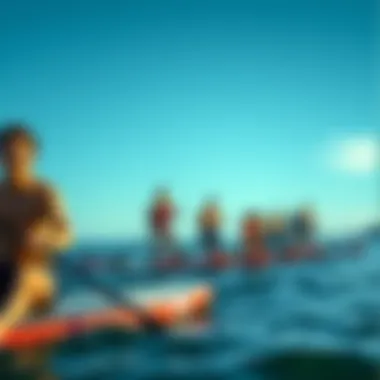
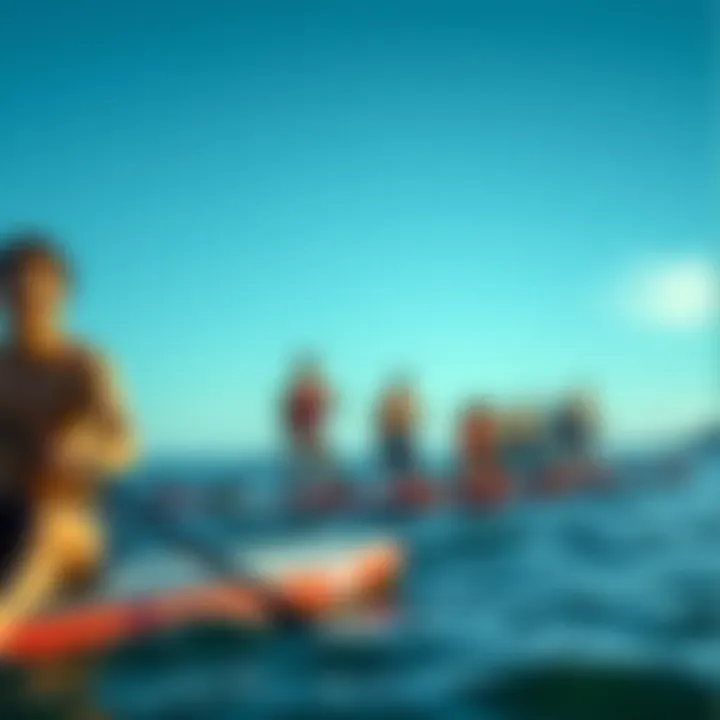
Environmental Considerations
When delving into the realm of power paddleboarding, one cannot overlook the significant foothold that environmental considerations have within the sport. This water activity, much like any other, carries an inherent obligation to address its impact on the world’s ecosystems and environment. A mindful approach towards paddleboarding lends itself to maintaining aquatic health and promoting sustainable habits, which resonate with eco-conscious enthusiasts and water sport devotees alike.
Impact on Marine Ecosystems
The relationship between paddleboarding activities and marine ecosystems stands as a delicate balance. Power paddleboarding, while providing thrills and a unique way to explore, can impact aquatic environments negatively, if not approached with care.
Key points to consider include:
- Noise Pollution: Having motors on paddleboards can instigate noise distractions for marine wildlife, impacting their natural behaviors during foraging and mating.
- Propeller Impact: The use of propellers can inadvertently disturb the seafloor, affecting habitats that marine organisms depend on.
- Chemical Pollution: Fuel spills or gear maintenance can lead to chemical substances entering the water, harming the delicate ecosystems.
Adopting strategies to mitigate these impacts is crucial for the sustainability of marine environments. Enthusiasts are encouraged to choose electric-powered options which typically generate less noise and have reduced environmental footprints.
Sustainable Practices
Embracing sustainable practices is essential in promoting the longevity of power paddleboarding as both a sport and an ecological activity.
Responsible Usage
Responsible usage refers to the mindful engagement with paddleboarding and water sports to minimize environmental impact. This approach advocates for:
- Educating Users: Sharing information about the best practices to keep marine environments safe. This characteristic makes responsible usage a favorable method among the paddleboarding community.
- Conscientious Behavior: Choosing to avoid sensitive areas such as coral reefs or marine protected zones protects vulnerable ecosystems.
- Equipment Maintenance: Regular checks on equipment can prevent damages that could lead to pollution.
The unique feature of responsible usage is its blend of awareness and action that empowers paddlers to contribute positively to marine conservation while enjoying their leisure time. It acknowledges the need for balance between recreation and environmental stewardship, making it an ideal notion for this guide.
Local Regulations
Local regulations play a pivotal role in framing the boundaries of paddleboarding within various ecosystems. These rules are shaped by the communities and environmental agencies to safeguard local waters.
- Waterway Restrictions: Many regions enforce restrictions on where paddleboards can operate, reducing disturbances to wildlife habitats.
- Permitting: Some areas may require permits for specific activities, ensuring that usage is monitored and remains sustainable.
A key characteristic of local regulations is that they adapt; they evolve based on environmental studies and community feedback, making them a reliable choice for those engaged in paddleboarding activities. Such regulations echo an adaptable response to the needs of both the sport and the environment, underscoring their significance in competitive and recreational contexts alike.
Moving toward a future where power paddleboarding thrives sustainably is achievable through collective responsibility. Both individuals and communities have steeped interest in ensuring that the waters remain vibrant for years to come.
The Lifestyle of Power Paddleboarding
Power paddleboarding isn't just about zipping over water; it's a lifestyle that blends adventure with leisure. This sport has carved out its niche within larger surfing and outdoor communities, transforming the way enthusiasts engage with aquatic environments.
The lifestyle associated with power paddleboarding goes beyond mere participation; it's about embracing a symbiotic relationship between people and water, community connections, and a profound appreciation for nature. The accessibility and versatility of power paddleboarding create unique opportunities for social bonding, fitness, and exploration.
Cultural Significance in Surf Communities
In many surf communities, power paddleboarding has found its way into local culture as a respected form of water sport. The dress, the lingo, and the passion all combine to form an identity among enthusiasts. It's common to see paddleboarders engaging in meet-ups or participating in local competitions.
Power paddleboarding often serves as a bridge for surfers who want to extend their time on the water. It offers a different approach to the waves and creates a friendly rivalry among users.
- Community Events: It's not just a one-person sport. Group outings and community events promote camaraderie and create shared experiences. You might find a local group that runs regular outings or participates in charitable events, fostering a sense of belonging.
- Innovative Styling: Enthusiasts often find new ways to express their passions with the gear they use and how they display it. Custom paddleboards and unique gear become statements of identity and creativity.
- Tradition Meets Modernity: Paddleboarding maintains ties to traditional water sports while incorporating modern technology—an evolution that adds depth and excitement to the culture.
Travel Destinations for Power Paddleboarding
With the rising popularity of power paddleboarding, numerous travel destinations have emerged as prime spots for enthusiasts. These locations cater to both novice and expert paddlers alike, offering envious vistas and fantastic conditions for paddling.
Some notable travel spots include:
- Lake Tahoe, California: Famous for its clear waters and stunning mountain backdrop, Lake Tahoe is a fantastic destination for a paddleboard getaway. Here, calm waters allow paddlers to take in sights of nature while cruising.
- Tulum, Mexico: With its warm climate, Tulum is tropical paradise for paddleboarding, where you can glide over turquoise waters while exploring ancient ruins nearby.
- The Florida Keys: A collection of islands off the southern coast of Florida, the Keys provide easy access to mangroves and coral reefs, perfect for eco-conscious paddlers seeking to blend sport with exploration.
- Haleiwa, Hawaii: A gem on the North Shore, Haleiwa offers everything from tranquil waters to challenging ocean paddling, all set against breathtaking Hawaiian scenery. It's a must-visit for power paddleboarding lovers.
"The allure of water, the thrill of speed, and the connections formed on the board—power paddleboarding is a lifestyle that leaves its mark on those who embrace it."
By choosing these locales, paddleboarders can not only engage with their sport but also immerse themselves in diverse cultures, cuisines, and other outdoor activities. This adds layers to the experience, making power paddleboarding much more than just a recreational activity; it becomes a way to explore the world.
In summary, the lifestyle surrounding power paddleboarding encompasses not just the activity itself, but a broader cultural significance and a means to experience new places. It reflects community bonding, personal expression, and the exploration of beautiful environments that beckon enthusiasts from all walks of life.
Future of Power Paddleboarding
The future of power paddleboarding is poised at the intersection of innovation and growing enthusiasm. As the sport develops, its importance within the broader context of water sports becomes increasingly evident. This section explores what lies ahead for power paddleboarding, focusing on emerging technologies, the expanding community, and the environmental considerations woven into its evolution.
Technological Innovations on the Horizon
Looking ahead, technology will play a pivotal role in shaping power paddleboarding's landscape. The integration of advanced propulsion systems is one of the key aspects. Manufacturers are exploring options like lighter batteries, utilizing sustainable materials, and optimizing electronic components for enhanced performance and longevity. These innovations promise not only improved speed but also longer durations on the water without frequent recharges.
Moreover, smart features are beginning to make their way into paddleboards. Think about connectivity with apps that can track your speed, distance, and battery levels—providing data right at your fingertips. Imagine having an onboard navigation system that alerts you to changing weather conditions or nearby hazards. Such advancements not only enhance user experience but also contribute to safety on the water, making power paddleboarding more accessible and appealing to newcomers.
- Lighter Materials: Use of carbon fiber and other composites to reduce weight.
- Battery Life: Innovations aimed at doubling or tripling run times.
- Smart Features: Integration of GPS and performance tracking technologies.
"Adaptation to new technological trends will not only expand the appeal of power paddleboarding but also ensure its safety, sustainability, and user enjoyment."
Potential Growth of the Sport
As interest grows, the sport anticipates a surge in participation from various demographics. One strong signal of this potential growth is the rise in community events and competitions aimed at both beginners and seasoned paddlers. Such gatherings foster a sense of camaraderie, create networks for sharing skills, and ultimately drive more people to try their hand at power paddleboarding.
This growth is not merely about numbers. It also reflects broader trends in outdoor recreation. People are increasingly looking for new ways to experience nature, push their limits, and enjoy leisure activities. As power paddleboarding continues to integrate cutting-edge technology with eco-friendly practices, it stands to become a favored choice for those seeking adventure while being mindful of their environmental impact.
The pandemic also served to peak interest as more individuals sought solace in outdoor activities. The trend shows no signs of waning, implying that paddleboarding—especially with added power—will capture an even larger share of the recreational market.
In summary, the future of power paddleboarding rests on enhancing technology, broadening accessibility, and fostering community engagement. This unique blend of innovation, sport, and environmental stewardship crafts a narrative of potential that is ripe for exploration and excitement.
Closure
Power paddleboarding is not just a sport; it’s an experience, a lifestyle, and for many, a delightful escape into nature. As explored throughout this article, the depth of power paddleboarding extends far beyond the basics of technology and gear. It genuinely connects enthusiasts with the elements, promoting a deeper understanding of marine environments and encouraging a culture centered around sustainability and responsible enjoyment of nature.
Summarizing Key Insights
The insights gleaned from the various discussions on power paddleboarding are multifaceted. To recap:
- Power paddleboarding merges innovation with recreation, showing how technology can enhance traditional sports.
- The accessibility this sport offers means individuals from various skill levels can engage, fostering community and camaraderie.
- Environmental considerations remind participants of their responsibility to protect aquatic ecosystems while enjoying them.
- Essential gear enhances safety and enjoyment, making it critical for every participant to understand what they might need.
Encouraging Future Participation
As we look ahead, the potential for power paddleboarding remains enormous. It invites more participants to dive into a unique blend of adventure, fitness, and fun. To encourage future involvement:
- Join local groups or clubs focused on paddleboarding, offering opportunities for learning, networking, and shared adventures.
- Explore organized events and competitions. These can provide not only a chance to show skills but also to enjoy the thrill of camaraderie.
- Become advocates for sustainability in the communities where paddleboarding thrives; promote awareness on local regulations and the significance of preserving water environments.
- Consider introducing friends and family to this engaging sport. You never know who might find their passion for the water alongside you.
Let's embrace the future of power paddleboarding together, ensuring that it continues to grow in enthusiasm and responsibility. For more information, check out resources like Wikipedia or community discussions on Reddit to keep the spirit alive.







